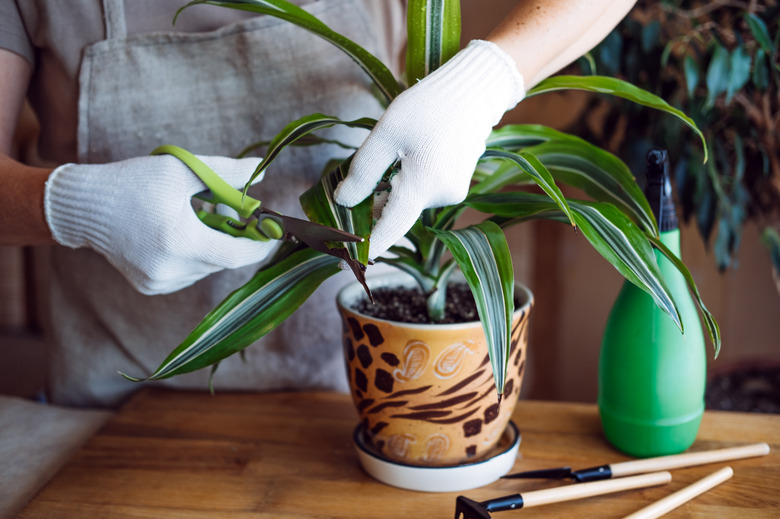How To Repot A Dracaena
We may receive a commission on purchases made from links.
If you desire a low-maintenance evergreen that performs well in containers and screams "tropical," a dragon tree (Dracaena marginata, USDA zones 10 to 11) won't disappoint. It's one of the more common dracaena varieties that makes a hardy and eye-catching addition when grown indoors or outdoors. It's a great choice for novice or forgetful gardeners because it doesn't take much to keep it looking fabulous, and best of all, you'll only have to repot it every couple of years.
Notable Dracaena Varieties and Characteristics
Notable Dracaena Varieties and Characteristics
Dracaenas are considered broadleaf evergreens that only tolerate growing outdoors year-round in frost-free, freeze-free climates. However, they also perform well when grown indoors as houseplants, so even those with frosty winters can enjoy this tropical beauty. Those with cold winters can move the containers outdoors during the warmer portion of the year and indoors to a warm and protected location before winter.
There are more than 160 dracaena varieties that belong in the Dracaenaceae family, with some more common than others. Other than dragon trees, several of the more common types include the corn plant (Dracaena fragrans, USDA zones 10 to 12) and song of India (Dracaena reflexa 'Variegata,' USDA zones 11 to 12). All grow well as potted plants indoors or outside and have the same potting requirements.
The popular dragon tree produces clumps of tall, thin stalks that have a curving habit and are topped with tufts of ribbonlike green leaves edged in reddish-purple. The cultivar 'Tricolor' sports ribbonlike green foliage edged in reddish-purple with a golden stripe. It takes many years for the tree to reach a mature height of 15 feet, so you don't have to worry about it quickly outgrowing its container. In fact, it can take up to 10 years for the plant to achieve a height of 3 feet.
Repotting a Dracaena
Repotting a Dracaena
Although like most dracaenas, dragon trees thrive on neglect when it comes to repotting, it's best to do so every couple of years. This allows you to give the root system fresh soil to continue growing healthily and alleviates the possibility of it becoming root-bound from growing too long in the same pot. Dracaenas allowed to remain root-bound can suffer wilting and have their health negatively affected by the too-cramped conditions. It's best to do any repotting in spring when the plant is actively growing.
When repotting, use a pot that is one size larger than the one in which the dracaena is presently growing and make sure it contains bottom drain holes to prevent rot problems. Use a fertile potting mix that drains well and fill the bottom third of the pot with the mix. Water the soil to settle. Remove the dracaena from its pot, check the roots for wrapping, and gently tease them apart if needed. Next, place the dracaena into the pot's center and backfill with the potting mix, being sure not to plant the dragon tree any deeper than it was originally growing. Firm up the soil around the plant's base and water the soil again until it runs out of the pot's bottom drain holes.
Aftercare and Basic Growing Tips
Aftercare and Basic Growing Tips
If you are growing your potted dragon tree indoors, place it in a location out of direct sunlight but where it receives bright, filtered light and temperatures range between 65 and 75 degrees Fahrenheit. When grown outdoors, place the container in a location receiving partial shade to partial sun for the best growth. Dracaenas are tolerant to drought, but watering when the top several inches of the potting mix become dry produces good growth. However, they are sensitive to fluoride, and affected foliage shows up as necrotic spots along the leaves. To reduce the possibility of damage, allow your water to sit out overnight before using it. You can also use rainwater or use water that is fluoride-free.
Dragon trees make indoor areas healthier, as the plant clears the air of toxins, like formaldehyde, xylene, trichloroethylene, and benzene. Although the plant is nontoxic to humans, including children, it does have toxic qualities that can poison your cat or dog. Be sure to place your dracaena in a location that is out of the reach of your pets.
